LES OEUVRES DE L’ATLAS VOUS INTÉRESSENT ?
Notre équipe est à votre disposition pour vous accompagner dans la création ou la gestion de votre collection d’œuvre d’art. Grâce à notre expertise du marché et à notre vaste réseau, nous vous offrons un service personnalisé et adapté à vos besoins, où que vous soyez.
OU
Contactez-nous via WhatsApp
Novembre 3 2022
Y-Jean Mun-Delsalle
“It’s between something totally gestural and something totally controlled. Normally in calligraphy, you don’t use rulers, but I wanted to do a kind of gestural geometry,” explains L’Atlas aka Jules Dedet Granel about his process. We’re standing in the middle of his atelier on the outskirts of Paris and he’s showing me his latest creations in his trademark black and white for a solo show set to open in January next year at Galerie Brugier-Rigail in Paris. Progressively lifting the pressure of his flat, wide and rigid calligraphy brushes – the first time he’s using such large ones, with some able to soak up to a liter of ink without dripping – as he meditatively crisscrossed his compositions on hanji (traditional Korean handmade mulberry paper), he painted them on the ground in black Rohrer & Klingner acrylic ink that doesn’t diffuse through the paper, although ultra liquid. “It’s the perfect medium, between ink and acrylic, so I can really take my time,” he notes. But don’t expect to see any Chinese calligraphic characters here. L’Atlas has invented his own visual language, producing backgrounds of his own design before laying down strips of tape, spray painting over them in white acrylic using Montana Water Based cans that give a perfectly mat aspect and peeling off the tape to reveal his stylized signature based on vertical and horizontal lines beneath.
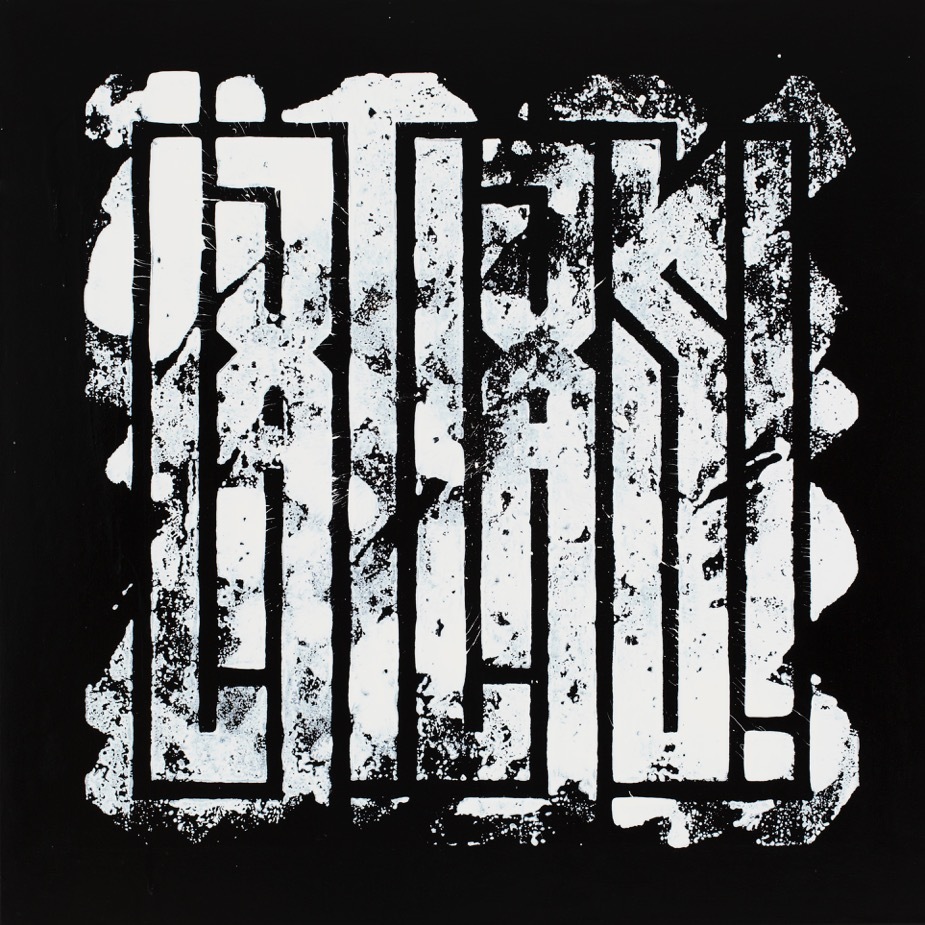
Recalling childhood memories of watching Bruce Lee on TV, L’Atlas imagined “Dragon’s Wrath” as an angry dragon’s tail, this time replacing his brush with a mop dipped in acrylic diluted with water and a gloss medium. With a single brushstroke, he completed the gesture in just 10 seconds, in accordance with calligraphy where one does everything in a single breath. He then raised the smooth, linoleum-like synthetic canvas vertically to let it drip, applied tape and superimposed his geometric logo using a spray paint can he pierced with a metal instrument, causing it to explode and mist the entire surface in a matter of seconds. “I love the idea that to paint such a large canvas, it didn’t even take 20 seconds,” he says. “I knew exactly that I was going to do this on the background. I had thought about it for a long time, for a week before. It’s like calligraphers – they’ll think of their gesture for a while, but the moment of doing it is at lightning speed. I didn’t want any legible character in my gesture, so it’s as if I abstracted the calligraphic gesture. I’ve watched so many calligraphers worldwide and in videos that I paint like one, as if I’m writing letters, but I don’t write any.”
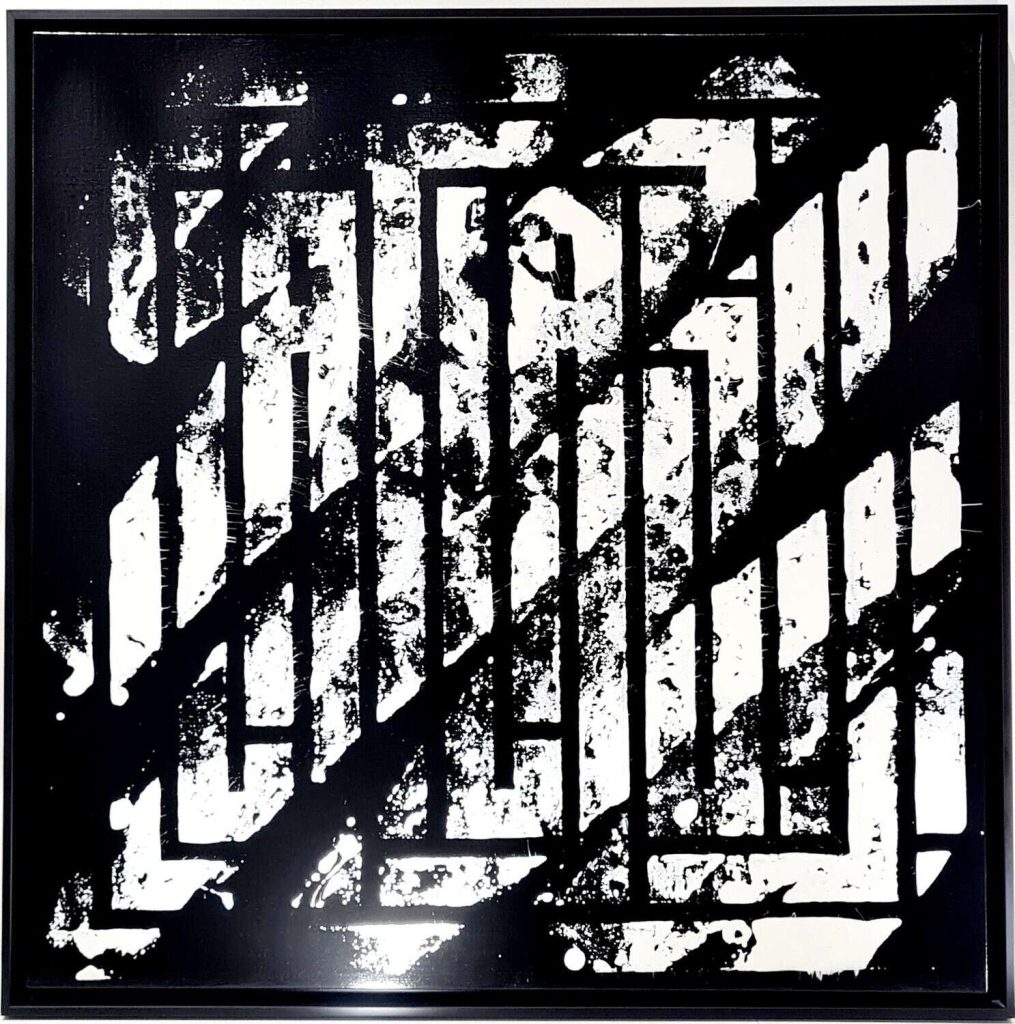
Similarly, the all blue pieces L’Atlas created for his current exhibition “Deep Breath” running until November 20, 2022 at Institut Culturel Bernard Magrez in Bordeaux employ the same technique of punctured spray paint cans for the backdrop, but then they’re sprinkled with marks generated by aerosols topped with plastic needle caps, thereby shifting from a wild, blurred image made standing a meter away from the canvas to very fine, precise and controlled traces produced up close. Over in Abidjan, his debut show in Africa, “A New Dream”, at ArtTime Gallery last month unveiled his primitive side through white paint splashes on raw linen, blue drips, prints made with oversized wooden stamps and black-and-white gestural works. On display was also his first-ever artwork made in collaboration with his wife, Iris Goutal, in which she painted with her body performing various postures on a gouache-covered canvas while in a deep trance state, leaving behind the imprint of this transient physical experience, and on top of which L’Atlas intervened with his logo.
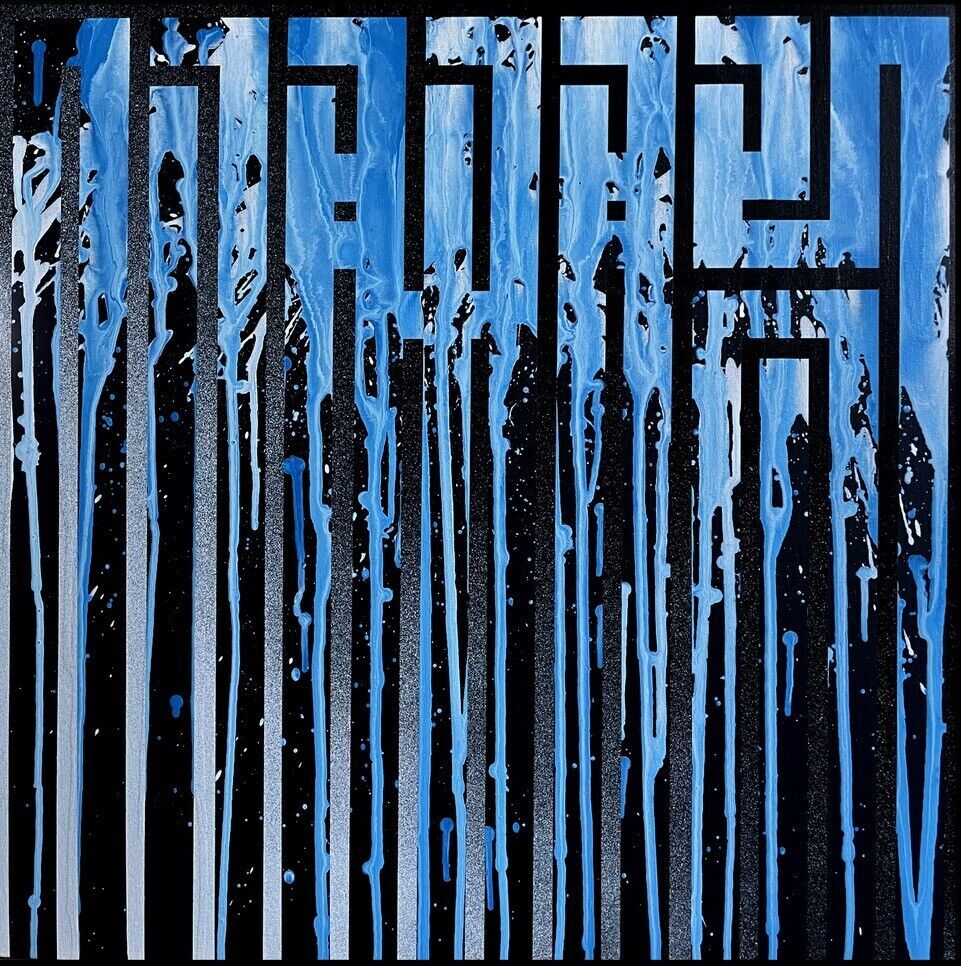
Born in Toulouse in 1978, L’Atlas’ roots may have been in the street in the 1990s when he tagged everything in sight, but his style has since evolved beyond graffiti, as he fuses the optical, abstract, minimalist and geometric art movements with his research on writing and calligraphy to produce an original typography. In the aim of creating a universal pictorial language, he has successfully embedded the history of writing into the history of art and brought optical art inside graffiti. Not one for labels, his creations defy easy categorization and have always served to break down the so-called psychological barriers that exist between various art movements. “I want to build bridges between movements and I always thought that superimposing two things – something very gestural and something very geometric – would create an additional optical retinal vibration, which is a way for me to make different art movements dialogue with one another,” he discloses.
This intermingling of worlds and quest for universality led L’Atlas – who chose his pseudonym so that it could be easily understood by all in any language – from France to Morocco, Egypt, Syria, China and Japan to study calligraphy, sigillography and tai chi with masters like Hassan Massoudy, Mounir Al Shaarani and Zhang Aijun, after having dropped out of university at the age of 21, where he had studied art history and archaeology. Today in search of new discoveries that result from new tools, in line with the philosophy of New Realism, an art movement founded in 1960 whose members included Pierre Restany, Yves Klein, Arman, Jean Tinguely, Martial Raysse, César and Niki de Saint Phalle, he states, “New ideas come from new techniques or new materials. When I come to my studio, it’s not what I’m going to do, but how I’m going to do it that interests me. It’s the technical process that takes me further. The New Realists explained that it is the fact that artists used the tools of their time that makes art history evolve; we are dependent on technique. A whole new aesthetic was born because it was linked to tools, so it relates to the technical progress of society. I find this idea very true since each time I have a new instrument like a new aerosol paint or a new cap, it’s a new series.”
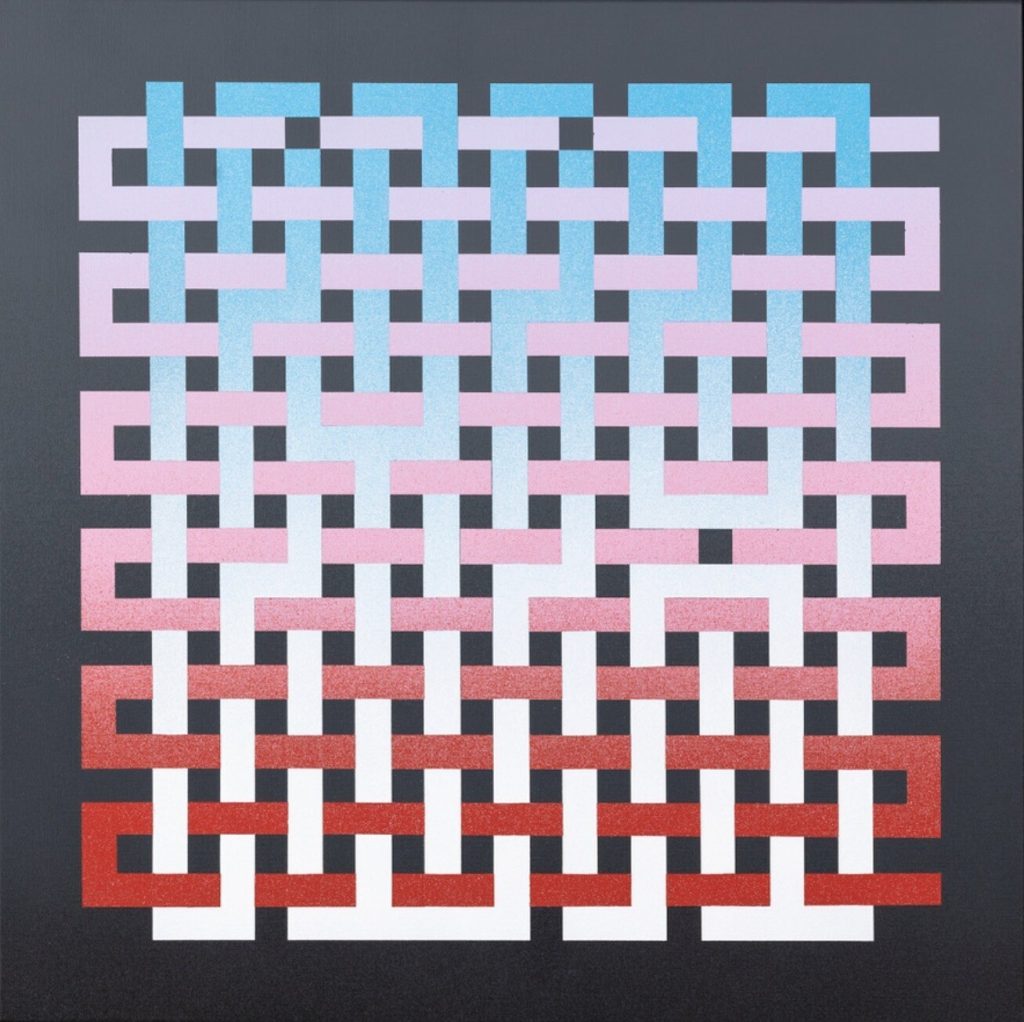
Sourcing his tools from fine art or DIY stores, L’Atlas also picks up squeegees from carwashes, using the sponge to apply ink and the flat, smooth rubber blade to remove it in a process of subtraction, resulting in varying nuances of gray. “The problem with painting is that you’re always adding, and when you add, at some point you’ve gone too far and it’s too late, whereas here I can go back and correct,” he admits. You’ll also find him ripping layers of paper advertisements from metro station walls and bringing them back to the studio to form the backdrop of his paintings in tribute to the torn poster works of New Realists Raymond Hains and Jacques Villeglé, or swiping metro furniture and street signs for his “City Fragments” exhibition, which was held last October at Galerie Perahia. Concurrently, the Parisian gallery launched his new eponymous monograph focusing on his black-and-white creations. Published by Skira, it is the most comprehensive book on his work to date and is currently on sale on his website and in bookstores around France. It will also be available as a special edition housed in a screenprinted Plexiglas box containing an original print, limited to 100 pieces, and may be pre-ordered now at: latlasshop@gmail.com. On November 9, 2022, L’Atlas will be signing his monograph at Artazart bookstore-gallery in Paris, followed by an autograph session next month at Brussels-based Extend Gallery, which will be hosting a solo show dedicated to the artist.
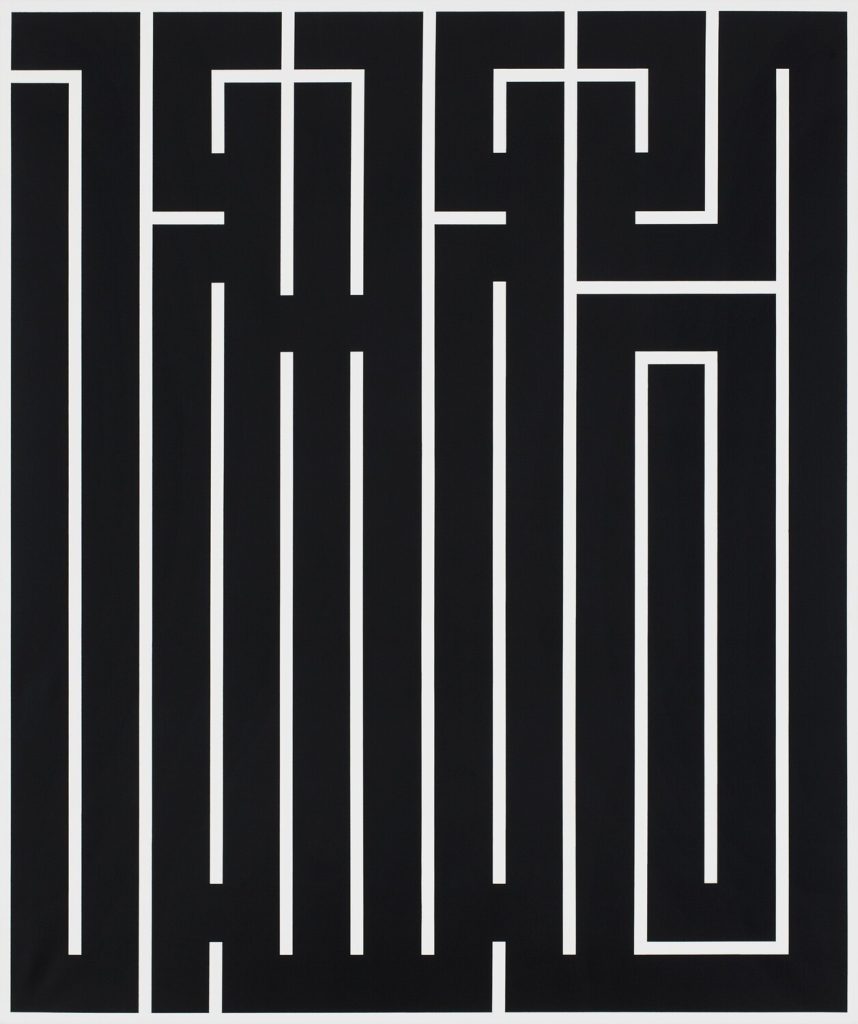
“My monograph is a way of taking stock, to look at everything I’ve done over the past 25 years as if I were a spectator, to take a step back and think, like in philosophy,” L’Atlas concludes. “It allows me to show my first love, the link with calligraphy, with fullness and emptiness. I work by asking myself, ‘Would I like to put this painting in my house?’ When I don’t want to sell it, that’s a good sign. Are you working for other people or for yourself? This book is like a personal introspection and going back to the beginning when I was 18: what do I like, what do I want to show? All my favorite pieces are in it, so it’s as if I made the book for myself. It’s an artwork in itself and also a silent, powerful tool that will allow me to reach out to new galleries.” A collection of his best works highlighting his subjects of predilection – abstraction, gesture and geometry – the book is set to be a true collector’s item, just like all of his creations.
LES OEUVRES DE L’ATLAS VOUS INTÉRESSENT ?
Notre équipe est à votre disposition pour vous accompagner dans la création ou la gestion de votre collection d’œuvre d’art. Grâce à notre expertise du marché et à notre vaste réseau, nous vous offrons un service personnalisé et adapté à vos besoins, où que vous soyez.
NEWSLETTER
Inscrivez-vous à notre newsletter pour ne rien manquer de l’actualité de Villa Domus : artistes, expositions, foires d’art et bien plus encore.
Galerie
Honfleur
45 Rue du Dauphin
14600 Honfleur
France
Bureaux
Honfleur
7 Rue des Capucins
14600 Honfleur
France
Newsletter
Inscrivez-vous à notre newsletter pour ne rien manquer de l’actualité de Villa Domus : artistes, expositions, foires d’art et bien plus encore.
© 2025 VILLA DOMUS | LEGAL INFORMATION